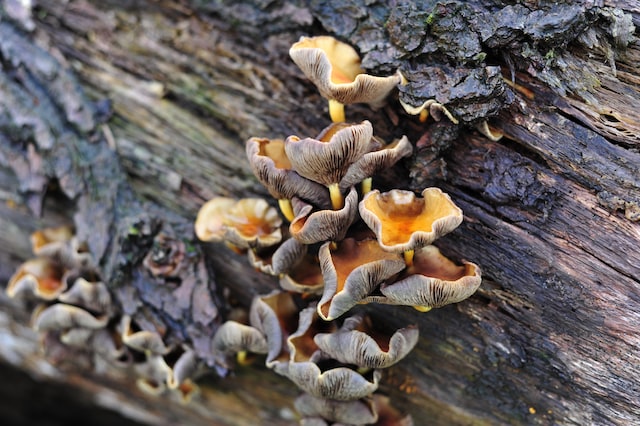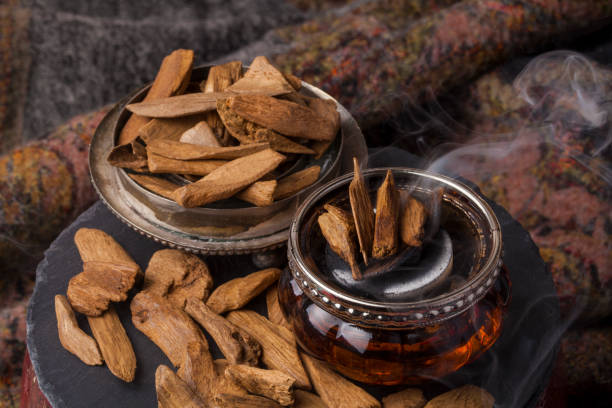Experience the Essence of Agarwood Oud
Oud: The Enigmatic Scent of the Orient
Introduction:
Oud, also known as agarwood or aloeswood, is a rare and highly prized aromatic resin derived from the heartwood of Aquilaria trees. This mystical fragrance has captivated cultures across the world for centuries and has been used in perfumes, therapeutic oils, and traditional medicine. With its rich history, unique scent profile, and remarkable healing properties, oud has become an enigmatic and sought-after treasure in the world of fragrances and beyond.
The Origin and Extraction of Oud:
The story of oud begins with the Aquilaria tree, native to Southeast Asia, particularly in countries like India, Cambodia, Thailand, and Indonesia. When the Aquilaria tree is infected with a specific type of mold or fungus, it undergoes a natural defense mechanism, producing a fragrant resin in its core. This resinous heartwood is what is known as oud.
The extraction of oud is a delicate and labor-intensive process. The Aquilaria tree must be carefully monitored and protected until the resin is fully formed. The resin-infused heartwood is then harvested, and the oud is extracted through various methods, including steam distillation and solvent extraction.
The Allure of Oud in Perfumes and Fragrances:
Oud is often referred to as "liquid gold" due to its rarity and captivating scent. Its fragrance is complex, with warm, woody, and balsamic notes, often accompanied by sweet, floral, and even animalic undertones. This complexity and uniqueness have made oud an essential ingredient in luxury perfumes and fragrances.
The demand for oud-based fragrances has surged in recent years, with top perfume houses incorporating oud in their creations. The olfactory allure of oud has made it a favorite among perfumers, as it adds depth, complexity, and an oriental touch to any scent composition.
Therapeutic Uses and Medicinal System:
In addition to its use in perfumery, oud has been treasured for its therapeutic properties in traditional medicine. In many cultures, oud is believed to possess numerous healing benefits, including its ability to reduce stress and anxiety, enhance focus and concentration, and promote relaxation and mindfulness.
Oud oil and oud-infused products are used in aromatherapy for their calming and soothing effects. The aroma of oud is thought to have a positive impact on emotional well-being, making it a valuable tool in alternative medicine practices.
Historical Significance and Cultural Use:
Oud's history is steeped in ancient traditions and folklore. It has been revered in various cultures for centuries, from ancient civilizations in the Middle East to royal courts in India and the Far East. In many cultures, oud has been associated with luxury, spirituality, and even mystical powers.
Throughout history, oud has been a symbol of wealth and status. It was often used by royalty and nobility to scent clothing, adorn palaces, and enhance luxurious surroundings. In some cultures, oud was considered a precious gift to honor esteemed guests and mark special occasions.
Culinary Uses and Fun Crazy Facts:
While oud is mainly known for its use in perfumery and traditional medicine, it has also found its way into culinary practices in certain cultures. In some parts of the Middle East and Southeast Asia, oud-infused desserts and drinks are prepared to add a unique and exotic flavor to the dishes.
Oud's journey from the heartwood of the Aquilaria tree to the world of perfumes, therapeutic oils, and traditional medicine is a testament to its timeless allure and mystique. As a rare and precious fragrance, oud has left an indelible mark on cultures and societies worldwide
.
From its complex and captivating scent to its therapeutic benefits, oud continues to enchant and captivate fragrance enthusiasts and wellness seekers alike. Whether used in perfumes to create alluring scents or in traditional medicine to promote emotional well-being, oud's enigmatic essence remains a cherished treasure of the Orient.
Introduction:
Oud, also known as agarwood or aloeswood, is a rare and highly prized aromatic resin derived from the heartwood of Aquilaria trees. This mystical fragrance has captivated cultures across the world for centuries and has been used in perfumes, therapeutic oils, and traditional medicine. With its rich history, unique scent profile, and remarkable healing properties, oud has become an enigmatic and sought-after treasure in the world of fragrances and beyond.
The Origin and Extraction of Oud:
The story of oud begins with the Aquilaria tree, native to Southeast Asia, particularly in countries like India, Cambodia, Thailand, and Indonesia. When the Aquilaria tree is infected with a specific type of mold or fungus, it undergoes a natural defense mechanism, producing a fragrant resin in its core. This resinous heartwood is what is known as oud.
The extraction of oud is a delicate and labor-intensive process. The Aquilaria tree must be carefully monitored and protected until the resin is fully formed. The resin-infused heartwood is then harvested, and the oud is extracted through various methods, including steam distillation and solvent extraction.
The Allure of Oud in Perfumes and Fragrances:
Oud is often referred to as "liquid gold" due to its rarity and captivating scent. Its fragrance is complex, with warm, woody, and balsamic notes, often accompanied by sweet, floral, and even animalic undertones. This complexity and uniqueness have made oud an essential ingredient in luxury perfumes and fragrances.
The demand for oud-based fragrances has surged in recent years, with top perfume houses incorporating oud in their creations. The olfactory allure of oud has made it a favorite among perfumers, as it adds depth, complexity, and an oriental touch to any scent composition.
Therapeutic Uses and Medicinal System:
In addition to its use in perfumery, oud has been treasured for its therapeutic properties in traditional medicine. In many cultures, oud is believed to possess numerous healing benefits, including its ability to reduce stress and anxiety, enhance focus and concentration, and promote relaxation and mindfulness.
Oud oil and oud-infused products are used in aromatherapy for their calming and soothing effects. The aroma of oud is thought to have a positive impact on emotional well-being, making it a valuable tool in alternative medicine practices.
Historical Significance and Cultural Use:
Oud's history is steeped in ancient traditions and folklore. It has been revered in various cultures for centuries, from ancient civilizations in the Middle East to royal courts in India and the Far East. In many cultures, oud has been associated with luxury, spirituality, and even mystical powers.
Throughout history, oud has been a symbol of wealth and status. It was often used by royalty and nobility to scent clothing, adorn palaces, and enhance luxurious surroundings. In some cultures, oud was considered a precious gift to honor esteemed guests and mark special occasions.
Culinary Uses and Fun Crazy Facts:
While oud is mainly known for its use in perfumery and traditional medicine, it has also found its way into culinary practices in certain cultures. In some parts of the Middle East and Southeast Asia, oud-infused desserts and drinks are prepared to add a unique and exotic flavor to the dishes.
Oud's journey from the heartwood of the Aquilaria tree to the world of perfumes, therapeutic oils, and traditional medicine is a testament to its timeless allure and mystique. As a rare and precious fragrance, oud has left an indelible mark on cultures and societies worldwide
.
From its complex and captivating scent to its therapeutic benefits, oud continues to enchant and captivate fragrance enthusiasts and wellness seekers alike. Whether used in perfumes to create alluring scents or in traditional medicine to promote emotional well-being, oud's enigmatic essence remains a cherished treasure of the Orient.
To experience augmented reality, please open the Facebook-app using QR code and point to the image below
Elevate Your Senses with Resin Wood Perfume
Oud, also spelled oudh or agarwood, is a type of fragrant resin that is produced by trees of the Aquilaria species when they become infected with a type of mold. Oud is highly prized for its intense, woody, and balsamic aroma, and it is widely used in perfumery, incense, and traditional medicine. Oud is native to the forests of Southeast Asia, particularly in countries such as India, Indonesia, and Vietnam, and it is often referred to as "liquid gold" due to its high value and rarity.
Explore Our Luxury Fragrance Collection
Oud is produced when the trees of the Aquilaria species become infected with the mold Phialophora parasitica, which invades the tree's bark and causes the tree to produce a dark, fragrant resin as a defense mechanism. The resin is then extracted from the tree and aged for several years to enhance its aroma. Oud is classified into different grades based on its quality, color, and aroma, and it is often used as a base note in perfumes and incense to add depth and complexity to the fragrance. Oud is also used in traditional medicine systems in some parts of the world, such as Ayurveda and Chinese medicine, to treat a variety of health conditions.
Crafted Perfume Blends from Natural Resins
It is important to note that the trade and harvesting of oud can have negative impacts on the environment and on the livelihoods of local communities. Some species of Aquilaria trees are endangered or threatened due to overharvesting and illegal logging, and there are efforts underway to sustainably cultivate and harvest oud to reduce the impact on wild populations. Make your own oud perfume at scentopia siloso beach
Unveiling the Allure of Oud Fragrances
Oud oil, also spelled oudh oil or agarwood oil, is an essential oil that is extracted from the fragrant resin of trees of the Aquilaria species, which are native to Southeast Asia. Oud oil is highly prized for its intense, woody, and balsamic aroma, and it is widely used in perfumery, incense, and traditional medicine. Oud oil is produced when the trees of the Aquilaria species become infected with the mold Phialophora parasitica, which invades the tree's bark and causes the tree to produce a dark, fragrant resin as a defense mechanism. The resin is then extracted from the tree and aged for several years to enhance its aroma, and it is distilled to produce the essential oil.
Oud oil is used as a base note in perfumes and incense to add depth and complexity to the fragrance, and it is also used in traditional medicine systems in some parts of the world, such as Ayurveda and Chinese medicine, to treat a variety of health conditions. Oud oil is said to have anti-inflammatory, analgesic (pain-relieving), and antispasmodic properties, and it is also used in aromatherapy and massage therapy to help relax the mind and body.
Oud oil is used as a base note in perfumes and incense to add depth and complexity to the fragrance, and it is also used in traditional medicine systems in some parts of the world, such as Ayurveda and Chinese medicine, to treat a variety of health conditions. Oud oil is said to have anti-inflammatory, analgesic (pain-relieving), and antispasmodic properties, and it is also used in aromatherapy and massage therapy to help relax the mind and body.
The Art of Agarwood Oud Extraction
Oud perfume, also spelled oudh perfume or agarwood perfume, is a type of fragrance that is made with oud, a fragrant resin that is produced by trees of the Aquilaria species when they become infected with a type of mold. Oud is highly prized for its intense, woody, and balsamic aroma, and it is widely used in perfumery, incense, and traditional medicine. Oud is native to the forests of Southeast Asia, particularly in countries such as India, Indonesia, and Vietnam, and it is often referred to as "liquid gold" due to its high value and rarity.
Oud perfume is made by blending oud oil with other essential oils and aroma compounds to create a unique fragrance. Oud perfumes are known for their rich, complex, and long-lasting aroma, and they are often used as base notes in perfumery to add depth and longevity to the fragrance. Oud perfumes are popular in many parts of the world, particularly in the Middle East, and they are often associated with luxury and exclusivity. Oud perfumes are available in a wide range of styles and concentrations, ranging from light and subtle to bold and intense. It is important to note that the trade and harvesting of oud can have negative impacts on the environment and on the livelihoods of local communities, and there are efforts underway to sustainably cultivate and harvest oud to reduce the impact on wild populations.
Oud perfume is made by blending oud oil with other essential oils and aroma compounds to create a unique fragrance. Oud perfumes are known for their rich, complex, and long-lasting aroma, and they are often used as base notes in perfumery to add depth and longevity to the fragrance. Oud perfumes are popular in many parts of the world, particularly in the Middle East, and they are often associated with luxury and exclusivity. Oud perfumes are available in a wide range of styles and concentrations, ranging from light and subtle to bold and intense. It is important to note that the trade and harvesting of oud can have negative impacts on the environment and on the livelihoods of local communities, and there are efforts underway to sustainably cultivate and harvest oud to reduce the impact on wild populations.
Join Scentopia, Sentosa's latest tourist attraction wonderful orchid scent crafting, fragrance tour, bridal shower or corporate team building which includes perfume making onsite and offsite, beach activities and more. We also serve primary school learning journey, secondary students and pupil on industrial excursions. Know more about our orchids perfume bar or therapeutic orchid scents and other wellness aromas. Conatct Perfume workshop or book a scent crafting session here.






